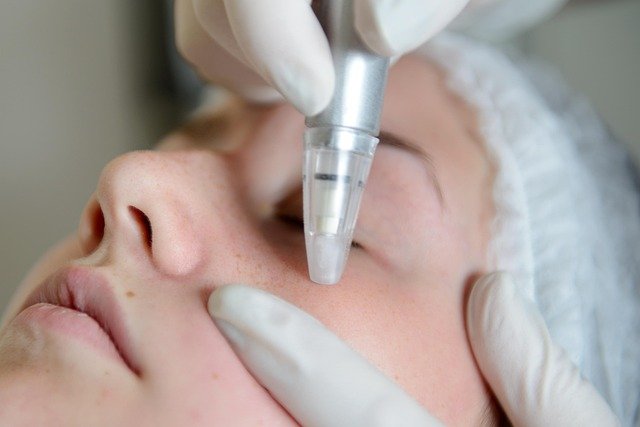Revitalize Your Skin: A Complete Guide to Laser Treatments in the U.S.
The quest for flawless, youthful skin has led many Americans to explore innovative cosmetic procedures. Among these, laser skin treatments have emerged as a revolutionary solution, offering non-invasive ways to address various skin concerns. This comprehensive guide delves into the world of laser skin treatments, exploring their benefits, types, and what to expect when considering this cutting-edge approach to skin rejuvenation.

What are laser skin treatments and how do they work?
Laser skin treatments utilize focused light energy to target specific skin issues. These treatments work by delivering controlled heat to the skin’s layers, stimulating collagen production and promoting cell renewal. The process can address a wide range of concerns, from fine lines and wrinkles to hyperpigmentation and acne scars. By precisely targeting problem areas, laser treatments can achieve remarkable results without the need for invasive surgery or lengthy recovery periods.
What skin conditions can laser treatments effectively address?
Laser skin treatments are versatile and can tackle numerous skin concerns. They are particularly effective for:
-
Wrinkle reduction
-
Scar removal, including acne scars
-
Sun damage and age spots
-
Uneven skin tone and texture
-
Enlarged pores
-
Facial redness and broken capillaries
The ability to customize treatments based on individual needs makes laser therapy a popular choice for those seeking comprehensive skin rejuvenation.
What are the different types of laser treatments available?
The field of laser skin treatments offers a variety of options, each designed to address specific concerns:
-
Ablative lasers: These remove the outer layer of skin, ideal for deep wrinkles and severe scars.
-
Non-ablative lasers: Less intense, these target the underlying skin without damaging the surface, perfect for mild to moderate skin issues.
-
Fractional lasers: These treat a fraction of the skin at a time, allowing for faster healing.
-
IPL (Intense Pulsed Light): While not technically a laser, IPL devices use light energy to target pigmentation and redness.
Choosing the right type depends on your skin concerns, downtime tolerance, and desired results.
What should you expect during and after a laser treatment?
During a laser treatment session, you may experience a sensation similar to a rubber band snapping against your skin. Most practitioners apply a numbing cream beforehand to minimize discomfort. Sessions typically last 30 minutes to an hour, depending on the treatment area and type of laser used.
Post-treatment, you can expect some redness and swelling, which usually subsides within a few days. More intensive treatments may require a longer recovery period. It’s crucial to follow your provider’s aftercare instructions, which often include avoiding sun exposure and using specific skincare products to enhance results and protect your skin.
How do you choose the right laser treatment and provider?
Selecting the ideal laser treatment and a qualified provider is crucial for achieving optimal results. Consider the following factors:
-
Skin type and concern: Different lasers are better suited for specific skin types and issues.
-
Provider expertise: Look for board-certified dermatologists or plastic surgeons with extensive experience in laser treatments.
-
Technology: Ensure the clinic uses FDA-approved, up-to-date laser equipment.
-
Before and after photos: Review the provider’s portfolio to gauge their skill and results.
-
Consultation: A thorough consultation should assess your needs and set realistic expectations.
Research local providers, read reviews, and don’t hesitate to ask questions about their experience and approach to laser treatments.
What are the costs and considerations for laser skin treatments?
The cost of laser skin treatments can vary significantly based on the type of laser, treatment area, and number of sessions required. Here’s a general pricing guide for common laser treatments in the U.S.:
| Treatment Type | Average Cost Per Session | Number of Sessions |
|---|---|---|
| Ablative Laser Resurfacing | $1,500 - $3,000 | 1-2 |
| Non-ablative Laser | $800 - $1,500 | 3-5 |
| Fractional Laser | $1,000 - $2,500 | 3-5 |
| IPL Treatment | $400 - $600 | 3-6 |
Prices, rates, or cost estimates mentioned in this article are based on the latest available information but may change over time. Independent research is advised before making financial decisions.
When considering laser treatments, factor in potential additional costs such as pre-treatment skincare products, post-treatment care, and any follow-up appointments. Many providers offer package deals for multiple sessions, which can provide savings for treatments requiring several visits.
Insurance typically doesn’t cover laser skin treatments for cosmetic purposes. However, some medical conditions treated with lasers may be eligible for coverage. Always check with your insurance provider and discuss financing options with your chosen clinic.
In conclusion, laser skin treatments offer a powerful solution for those seeking to revitalize their skin and address various cosmetic concerns. With advancements in technology and a wide range of options available, finding the right treatment for your specific needs has never been more accessible. By understanding the types of lasers, what to expect, and how to choose a qualified provider, you can make an informed decision about incorporating laser treatments into your skincare regimen. Remember, the key to success lies in selecting a skilled practitioner and following their guidance throughout the treatment process.
This article is for informational purposes only and should not be considered medical advice. Please consult a qualified healthcare professional for personalized guidance and treatment.




